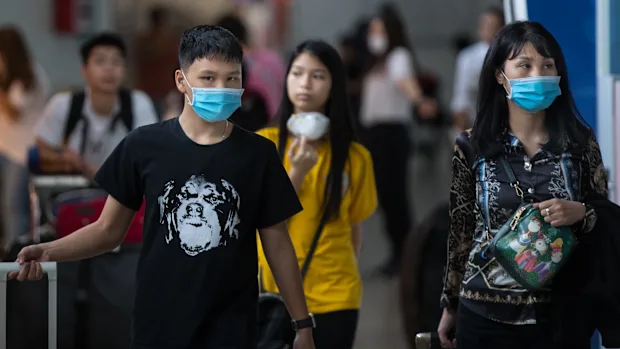4 New Coronavirus Symptoms You Shouldn’t Ignore as the Strain Spreads Globally
As new COVID-19 variants emerge globally, health experts warn of 4 new symptoms you shouldn’t ignore. Learn the latest signs, how they differ, and when to seek medical help
Although the COVID-19 pandemic was officially declared over, the virus continues to evolve. New Omicron subvariants like NB.1.8.1 (“Nimbus”) and XFG/XEC are circulating globally—and while generally milder, these strains have introduced distinct new symptoms that suggest shifts in how the virus affects the body

Health authorities warn that even non-classic symptoms—those not resembling cold or flu—should not be dismissed. Here’s a full breakdown.
One of the most alarming symptoms emerging with NB.1.8.1, nicknamed Nimbus, is an extremely painful sore throat—often described as feeling like swallowing razor blades
What to watch for: Severe, scratchy throat pain that’s far beyond usual sore throat.
Why it matters: This symptom appears more frequently with Nimbus compared to earlier variants, and can help differentiate COVID from seasonal allergies or strep throat .
When to act: If you’re using home care—hydration, throat lozenges, pain relief—and the pain persists or worsens, consider a PCR or rapid antigen test, and see a doctor.
Variants like XEC are presenting increasingly with gastrointestinal symptoms, particularly nausea, vomiting, diarrhea, and abdominal discomfort
- What to look out for: Sudden onset of loose stools, persistent nausea, or unexplained vomiting—especially without respiratory symptoms.
- Why it’s serious: These symptoms could lead to dehydration, particularly in vulnerable groups (elderly, chronic conditions).
- Medical advice: Maintain hydration, use electrolytes, and if symptoms are severe or persistent (>48 hours), seek evaluation and appropriate testing.
Though fatigue has long been a COVID staple, current variants are often producing prolonged exhaustion, lethargy, and difficulties concentrating—symptoms commonly described as “brain fog”, or early markers of Long COVID .

- What to observe: Mental fog, forgetfulness, difficulty completing daily tasks, or excessive tiredness climbing stairs.
- Significance: These symptoms may start during acute illness or linger for weeks as post-viral syndrome.
- What you should do: Pace your activity—rest, and if symptoms continue beyond 4 weeks, consult a provider to explore rehabilitation or therapy.
Even though variants are milder overall, some patients—particularly those with existing heart or lung issues—report subtle shortness of breath and chest tightness rather than classic cough. These signs may be early indicators of complications like pneumonia or myocarditis .
- Symptoms to take seriously: Mild breathlessness during routine tasks, vague chest pressure, or slight wheezing.
- Why it matters: Early detection can prevent progression to more serious conditions.
- Recommended actions:
- Monitor oxygen saturation using a pulse oximeter.
- Seek care if SpO₂ ≤ 94%, or if you experience chest pain, faster heartbeat, or confusion.
- NB.1.8.1 (“Nimbus”): Known for the excruciating sore throat, confirmed in over 22 countries, though not causing more severe disease overall
XEC: The most dominant variant (~45%) in parts of the U.S. and UK, commonly presenting with GI issues and cognitive symptomsVariants under monitoring are more transmissible but often allow milder symptoms, causing complacency. Hospitals remain stable, but case numbers can be misleading due to reduced testing
Many of these symptoms mimic allergies, common colds, or stomach bugs—leading to missed COVID diagnoses unless testing is done.
✅ 1. Test Promptly
- Prefer RT‑PCR or high-quality rapid antigen tests when symptoms appear.
- If antigen tests are negative but symptoms persist, do a PCR follow-up.
✅ 2. Isolate Until Resolution
- Even if mild, isolate for at least 5 days or until fever and major symptoms resolve.
- Wear masks around others, especially indoors or when vulnerable people are present.
✅ 3. Treat Symptomatically
- Razor‑blade sore throat: Warm drinks, lozenges, and acetaminophen.
- GI symptoms: Rehydration salts, bland diet, and rest.
- Fatigue/brain fog: Balanced meals, hydration, short breaks during rest.
- Breathlessness: Monitor oxygen; seek treatment early if issues arise.
| Symptom | Seek Medical Care If… |
|---|---|
| Chest discomfort | Chest pain, pressure, tightness |
| Breathlessness | SpO₂ ≤ 94% or increasing shortness |
| Severe GI distress | Dehydration signs (dizziness, low urine output, confusion) |
| Nervous system effects | Persistent confusion, severe fatigue, memory loss |
Stay updated with boosters, especially if it’s been 6+ months since your last dose
Use masks in crowded indoor settings.
Ventilate rooms, wash hands frequently, and sanitize surfaces.
Avoid close contact with high-risk individuals when symptoms appear.
Consider antiviral medications like Paxlovid for high-risk individuals—treatments are still effective
- Excruciating sore throat reminiscent of razor blades
- Nausea, vomiting, nausea-induced diarrhea
- Severe fatigue or cognitive fog
- Early respiratory warning signs like mild breathlessness or chest tightness
These symptoms may seem mild, but in vulnerable individuals, they can lead to serious complications. Prompt recognition, testing, and care can significantly reduce long-term issues—including Long COVID, affecting up to 30% of mild cases and 70% of hospitalized patients
Read Also : IMD Declares Monsoon 2025 Over Delhi & All of India After 89 Days of Rain








